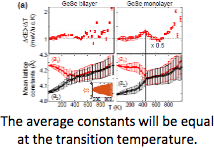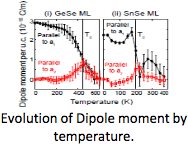Electronic Properties of Group IV Mono-Chalcogenides 2D Materials - Magnetism in 2D Materials
Student: Mehrshad Mehboudi
Degree: Ph.D., May 2018
Major Professor: Dr. Salvador Barraza-Lopez
Research Area(s):
Modeling & Simulation
Background/Relevance
- Two dimensional atomic materials –consisting of only one sheet of atoms- are studied extensively since 2005.
- Group IV mono-chalcogenides are layered materials that can in principle be exfoliated down to a single layer.
- Monolayer of CrSiTe3 is a 2D material with magnetism behavior.
Innovation
- Realization of structural phase transitions that modify material properties of 2D materials.
- Realization of asymmetric atomic structure in CrSiTe3.
Approach
- Car-Parrinello Molecular Dynamics with SIESTA DFT code; analysis of instantaneous average structures to extract changes in material properties.
- Density functional theory as implemented in VASP code will be used to investigate electronic band structure, ionic and electronic polarization.
- SIESTA code will be use to calculate optical properties of monolayer of monochalcogenides.
- For CrSiTe3, the total energy of the structure at symmetric and asymmetric conditions were calculated and compared.
Key Results
- Monochalcogenide monolayers undergo structural disorder before melting point. This disorder is in the form of bond reassignment
- Dipole moment of unit cell which contributes to piezoelectric effect reduces vs temperature as a result of disorder.


Conclusions
- There are strong effect of phase transition on the properties of monolayer of monochalcogenides.
- CrSiTe3 monolayer is anti-ferromagnetic and has an asymmetric structure
Future Work
- Phonon calculation of symmetric and asymmetric structure gives better understanding of the ground state of CrSiTe3 monolayer.
